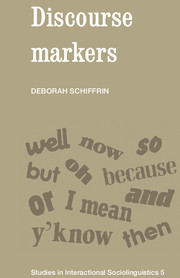Book contents
- Frontmatter
- Contents
- Acknowledgements
- Intonation and transcription conventions
- 1 Background: What is discourse?
- 2 Prelude to analysis: Definitions and data
- 3 Questions: Why analyze discourse markers?
- 4 Oh: Marker of information management
- 5 Well: Marker of response
- 6 Discourse connectives: and, but, or
- 7 So and because: Markers of cause and result
- 8 Temporal adverbs: now and then
- 9 Information and participation: y'know and I mean
- 10 Discourse markers: Contextual coordinates of talk
- Notes
- References
- Author index
- Subject index
4 - Oh: Marker of information management
Published online by Cambridge University Press: 05 June 2012
- Frontmatter
- Contents
- Acknowledgements
- Intonation and transcription conventions
- 1 Background: What is discourse?
- 2 Prelude to analysis: Definitions and data
- 3 Questions: Why analyze discourse markers?
- 4 Oh: Marker of information management
- 5 Well: Marker of response
- 6 Discourse connectives: and, but, or
- 7 So and because: Markers of cause and result
- 8 Temporal adverbs: now and then
- 9 Information and participation: y'know and I mean
- 10 Discourse markers: Contextual coordinates of talk
- Notes
- References
- Author index
- Subject index
Summary
As we saw in Chapter 3, understanding discourse markers requires separating the contribution made by the marker itself, from the contribution made by characteristics of the discourse slot in which the marker occurs. We posed the following questions. Does an item used as a marker have semantic meaning and/or grammatical status which contributes to its discourse function? And how does such meaning interact with the sequential context of the marker to influence production and interpretation?
I examine two discourse markers in this chapter and the next – oh and well – whose uses are not clearly based on semantic meaning or grammatical status. Beginning our analysis with these markers will force us to pay particularly close attention to the discourse slot itself. This will put us on firmer methodological ground for analysis of markers whose semantic meaning and/or grammatical status interacts with their sequential location to produce their function.
This chapter focuses on oh. Oh is traditionally viewed as an exclamation or interjection. When used alone, without the syntactic support of a sentence, oh is said to indicate strong emotional states, e.g. surprise, fear, or pain (Oxford English Dictionary 1971, Fries 1952).
Information
- Type
- Chapter
- Information
- Discourse Markers , pp. 73 - 101Publisher: Cambridge University PressPrint publication year: 1987
